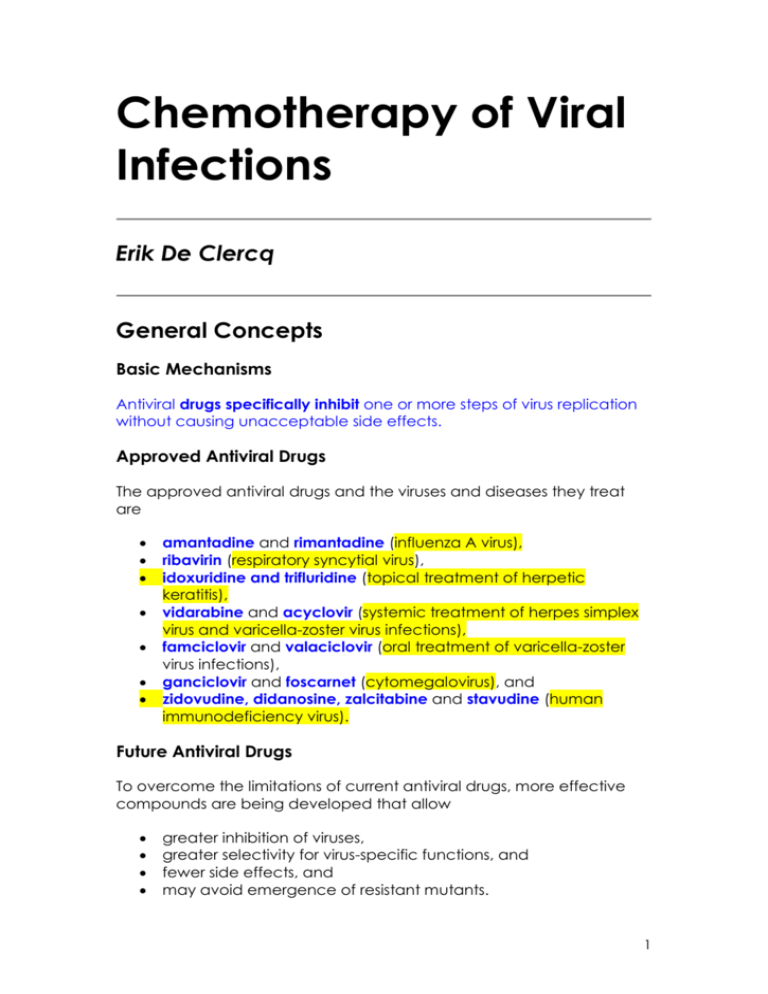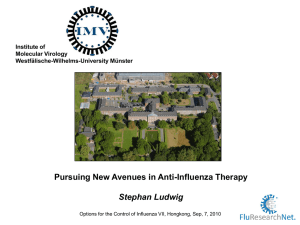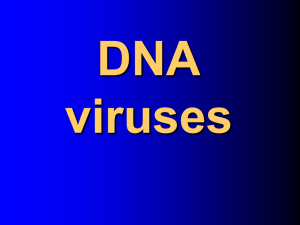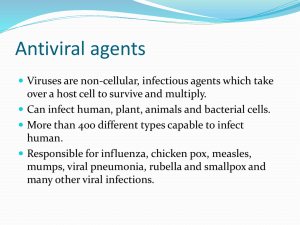Chemotherapy of Viral Infections
advertisement

Chemotherapy of Viral Infections Erik De Clercq General Concepts Basic Mechanisms Antiviral drugs specifically inhibit one or more steps of virus replication without causing unacceptable side effects. Approved Antiviral Drugs The approved antiviral drugs and the viruses and diseases they treat are amantadine and rimantadine (influenza A virus), ribavirin (respiratory syncytial virus), idoxuridine and trifluridine (topical treatment of herpetic keratitis), vidarabine and acyclovir (systemic treatment of herpes simplex virus and varicella-zoster virus infections), famciclovir and valaciclovir (oral treatment of varicella-zoster virus infections), ganciclovir and foscarnet (cytomegalovirus), and zidovudine, didanosine, zalcitabine and stavudine (human immunodeficiency virus). Future Antiviral Drugs To overcome the limitations of current antiviral drugs, more effective compounds are being developed that allow greater inhibition of viruses, greater selectivity for virus-specific functions, and fewer side effects, and may avoid emergence of resistant mutants. 1 Main Targets for Antiviral Drugs Specific events in virus replication identified as targets for antiviral agents are viral adsorption, penetration, uncoating, and viral nucleic acid synthesis as well as viral protein synthesis. Specificity for infected cells may occur when virus-specified enzymes (e.g., thymidine kinase-induced by herpes simplex virus or varicella-zoster virus) activate drugs (e.g., acyclovir). Limitations of Antiviral Drugs Limitations include a narrow antiviral spectrum, ineffectiveness against the latent virus, development of drug-resistant mutants and toxic side effects. INTRODUCTION We live in a time of rapid development of antiviral compounds. For selective chemotherapy of viral infections, a drug should inhibit virus replication when used at concentrations not detrimental to the host. A number of antiviral drugs have been formally licensed and are widely used for the chemotherapy of specific viral infections. Other antiviral agents are being developed. These fall primarily in three classes: anti-herpesvirus, anti-retrovirus, and, to a lesser extent, anti-rhinovirus compounds. The mechanisms of action targeting virus-specific events are being studied. Antiviral chemotherapy offers a decisive approach to the control of virus, notwithstanding some current limitations. 2 Basic Mechanisms Specificity against virus replication is the key issue in chemotherapy. Because of the close interaction between virus replication and normal cellular metabolism, it was originally thought too difficult to interrupt the virus replicative cycle without adversely affecting the host cell metabolism. It is now clear, however, that several events in the virus replicative cycle either do not occur in normal uninfected cells or are controlled by virus-specified enzymes that differ structurally and functionally from the corresponding host cell enzymes. Quite schematically, the virus replicative cycle can be divided into 10 steps (Fig. 52-1): (1) adsorption, (2) penetration, (3) uncoating, (4) early transcription, (5) early translation, (6) replication of the viral genome, (7) late transcription, (8) late translation, (9) assembly, and (10) release of new virus particles. Adsorption, penetration, and uncoating are typical examples of replicative events that are specific for virus infection and do not occur in uninfected cells (see Ch. 42). Examples of virus replication steps controlled by virus-specified enzymes are the transcription of positive-sense RNA to DNA (catalyzed by the reverse transcriptase associated with retroviruses), the replication of DNA to DNA (catalyzed by the DNA polymerases of herpesviruses), and the proteolytic cleavage of viral precursor proteins (catalyzed by the protease of human immunodeficiency virus). 3 FIGURE 52-1 Virus replicative cycle. The various steps in the replicative cycle at which the virus deviates from normal host processes are potential targets for chemotherapeutic intervention. It is not yet possible to tailor new antiviral agents to virusspecific target molecules. The molecular modes and targets of action for some of the approved antiviral drugs remain to be better defined. Approved Antiviral Drugs Antiviral compounds that have been formally licensed for clinical use are amantadine, rimantadine, ribavirin, idoxuridine, trifluridine, vidarabine, acyclovir, ganciclovir, foscarnet, zidovudine, didanosine, zalcitabine, stavudine, famciclovir and valaciclovir (Fig. 52-2). The clinical indications and dosage regimens for these drugs are presented 4 in Table 52-1. Their activity spectrum and mechanism of action are outlined in Tables 52-2 and 52-3. FIGURE 52-2 Approved antiviral drugs. 5 6 7 Amantadine and Rimantadine The clinical use of amantadine and rimantadine is restricted to the prophylaxis and early therapy of influenza A virus infections. Influenza prophylaxis is particularly indicated in immunodeficient patients, persons who are allergic to influenza vaccine, unvaccinated house contacts of high-risk patients, and residents of chronic care facilities where an outbreak of influenza A has been recognized. Amantadine is noted for its central nervous system side effects, such as hallucinations and disorientation, which lead, for example, to a risk of falling. Rimantadine causes fewer side effects than amantadine, when used at 8 the same dosage (200 mg/day, perorally). Influenza A virus resistance to both amantadine and rimantadine has been described. Ribavirin Although active against ortho- and paramyxoviruses, ribavirin (Virazole) is approved only for the treatment of respiratory syncytial virus (RSV) infection in infants. The drug is administered as a small-particle aerosol (particle diameter, 1 to 3 µm) so that it can reach the lower respiratory tract. Aerosolized ribavirin treatment results in more rapid cessation of viral shedding and resolution of clinical symptoms without signs of systemic toxicity. Idoxuridine and Trifluridine Because of their myelosuppressive, mutagenic and teratogenic effects following systemic administration, idoxuridine and trifluridine are only suitable for topical use. Trifluridine is superior to idoxuridine when used in eyedrops for the topical treatment of herpetic keratitis. Idoxuridine can be formulated for topical treatment of herpetic skin lesions. Vidarabine Vidarabine (Vira-A) is used for both topical and systemic treatment of herpes simplex virus (HSV) infections. A serious drawback is the poor solubility of this drug in aqueous media, which means that intravenous administration requires a large volume of fluid. When vidarabine and acyclovir were compared for efficacy in treating herpetic encephalitis and varicella-zoster virus (VZV) infection in immunocompromised hosts, acyclovir proved clearly superior to vidarabine. Vidarabine has various toxic side effects (i.e., tremor, ataxia, seizures, myalgia, nausea, vomiting, and diarrhea). Acyclovir is now generally preferred over vidarabine in the treatment of HSV and VZV infections. Acyclovir, Valaciclovir and Famciclovir Acyclovir (Zovirax) represents a major breakthrough in the treatment of herpesvirus infections. The main indications for its use are primary genital herpes, herpetic encephalitis and HSV and VZV infections in immunosuppressed patients. It can be used topically, intravenously, or perorally, although its oral absorption is only 20 percent. It offers limited benefit in the topical treatment of recurrent herpes labialis. It is also efficacious in preventing recurrent genital herpes, as well as in preventing HSV infections in renal allograft recipients. Based on an alteration of their thymidine kinase, HSV and VZV may develop resistance to acyclovir, particularly in immunocompromised patients. Valaciclovir (Valtrex) and Famciclovir (Famvir) represent two orally 9 bioavailable compounds for the treatment of HSV and VZV infections. Their main indication is herpes zoster. Valaciclovir and famciclovir act as prodrugs of acyclovir and penciclovir, respectively. Penciclovir acts in a similar fashion as acyclovir, although it would generate higher intracellular levels of the triphosphate form, which is supposed to be the active metabolite for these compounds. Ganciclovir, Foscarnet Ganciclovir (Cytovene) is the preferred drug for treating cytomegalovirus (CMV) infections in patients with acquired immune deficiency syndrome (AIDS) or other immunodeficiencies. It has very poor oral bioavailability (3 %), and, therefore, mostly given intravenously. Of the various clinical manifestations of cytomegalovirus infection in immunosuppressed patients, cytomegalovirus retinitis responds best to ganciclovir therapy, but recurs after treatment is stopped. The most frequent adverse side effects are granulocytopenia (neutropenia) and thrombocytopenia. Foscarnet (Foscavir) is the second drug used in the treatment of CMV infections, particularly CMV retinitis, in immunocompromised patients. It must be given intravenously, and it has proved effective in delaying progression of CMV retinitis compared to untreated controls. Zidovadine, Didanosine, Zalcitabine and Stavudine Zidovudine (Retrovir, AZT) is licensed for patients infected with human immunodeficiency virus type 1 or 2 (HIV-1 or -2), the agent of AIDS. It appears to impede progression of the disease, to lower the mortality rate and to diminish the frequency of opportunistic infections. The duration of the beneficial effects may be hampered by the emergence of resistant mutants. AZT is well absorbed orally (60 %) and readily crosses the blood-brain barrier. Serious side effects, particularly megaloblastic anemia and leukopenia, necessitate withdrawal of the drug in some patients. In addition to zidovudine, three other dideoxynucleosides, viz. didanosine (Videx, DDI), zalcitabine (Hivid, DDC) and stavudine (Zerit, D4T) have been licensed for the treatment of patients with HIV infection. All these compounds act in a similar fashion in that they are targeted at the reverse transcriptase. They all cause toxic side effects, particularly peripheral neuropathy (DDI, DDC and D4T) and pancreatitis (DDI). As these adverse reactions are not overlapping with those of AZT, both DDI and DDC have been used in combination with AZT in attempts to obtain better efficacy with lower toxicity. 10 Future Antiviral Drugs The importance of virus infections and the early successes with some antiviral drugs have prompted the search for new agents. This search has been focused on compounds that are active against herpesviruses, retroviruses, and rhinoviruses (Table 52-2). These antiviral drugs of the future are expected to be useful in clinical settings in which the approved antiviral drugs are not sufficiently efficacious. Among the yet to be approved antiviral compounds rank bromovinyldeoxyuridine (Helpin, BVDU) for the treatment of HSV-1 and VZV infections; cidofovir (Vistide, HPMPC) for the treatment of CMV infections (in particular CMV retinitis, where it confers a long-lasting suppression of the disease); and the HIV protease inhibitor saquinavir (Inverase) for the treatment of AIDS, where it may be combined with the dideoxynucleoside analogues (i.e. AZT and DDC) to achieve maximal benefit. Main Targets for Antiviral Drugs For rational drug design, the molecular targets (i.e., proteins or enzymes) should be identified first and then the drugs should be tailored on the basis of the molecular configuration and action of the target proteins. None of the antiviral drugs now available, or considered for clinical use, have been developed by rational drug design (except, to a certain extent, for the HIV protease inhibitors). Instead, their antiviral activity was found first, often by chance, and their molecular targets determined later. Antiviral compounds can be divided into two categories (1) those that can interact directly with their target Those approved compounds that do not require such activation are: amantadine, rimantadine, foscarnet and viral protease inhibitors. They interact directly with their target (viral adsorption, penetration, uncoating, HIV-1 reverse transcriptase or HIV protease). (2) those that must first be activated intracellularly by phosphorylation to the active (generally triphosphate) forms. In contrast, all nucleoside analogs, whether active as antiherpesvirus agents (such as acyclovir, ganciclovir, penciclovir or bromovinyldeoxyuridine) or anti-retrovirus agents (such as zidovudine and other dideoxynucleoside analogs) must be activated through three consecutive phosphorylation steps (although only two phosphorylations are required for the acyclic nucleoside phosphonates) before they can interact with their target enzyme, the herpesvirus DNA polymerase or retrovirus 11 reverse transcriptase. The triphosphates of the nucleoside analogs then compete with the natural substrates of the DNA polymerase or reverse transcriptase reaction. They can inhibit the incorporation of the natural substrates (e.g., dTTP and dGTP) into the growing DNA chain or can themselves become incorporated into DNA. This has been clearly demonstrated with a number of nucleoside analogs, such as idoxuridine, bromovinyldeoxyuridine, acyclovir, penciclovir, ganciclovir and zidovudine. The incorporation of acyclovir, zidovudine and the other dideoxynucleosides into DNA leads to termination of chain elongation; therefore, these compounds act as chain terminators. Antiviral selectivity may stem from the specific affinity of the antiviral compounds (or their activated forms) for their target protein (or enzyme). Alternatively, when phosphorylation is involved, antiviral selectivity may also evolve from the phosphorylation by a virusencoded thymidine kinase. Herpes simplex virus and varicella-zoster virus encode such virus-specific thymidine kinase, and since acyclovir and bromovinyldeoxyuridine are excellent substrates for the viral enzymes but poor substrates for the cellular thymidine kinase, their preferential phosphorylation by virus-infected cells, as compared to uninfected cells, significantly contributes to their selectivity as antiherpetic agents. Limitations of Antiviral Drugs As mentioned above, clinical use of the currently available antiviral drugs is limited by toxic side effects. There are also some general limitations inherent in antiviral chemotherapy (Table 52-4). 1. First, the more selective the antiviral drug the narrower its antiviral activity spectrum. 2. Second, since antiviral drugs target steps in virus replication, the latent phases characteristic of some viral (i.e. herpesviral) infections are not amenable to chemotherapy. This is particularly relevant for herpesvirus and retrovirus infections. Thus, eradication of latent virus infections is not feasible currently. 3. Third, antiviral drug treatment should be started early, before irreversible tissue damage occurs. Such timely treatment is not possible without early and accurate diagnosis, which is difficult for many viral infections (such as infections of the respiratory tract). 4. Fourth, perhaps inevitably for a specific antimicrobial agent, there is the risk of emergence of drug-resistant virus strains. This has been most dramatically demonstrated in AIDS patients from whom drug-resistant human immunodeficiency virus strains have 12 been isolated against virtually all the drugs that have been tried so far. In the same patients treated with acyclovir for HSV or VZV infections, acyclovir-resistant HSV or VZV strains have been detected. The fact that these HSV and VZV mutants, as well as the resistant HIV strains, retained full susceptibility to other antiviral agents is reassuring. These findings indicate that on the one hand, combination therapy should be studied, particularly for the prevention of HIV drug resistance, and that, on the other hand, attempts to develop new antiviral agents should continue unabated. REFERENCES Bean B: Antiviral therapy: current concepts and practices. Clin Microbiol Res 5:146, 1992 Crumpacker CS: Molecular targets of antiviral therapy. New Engl J Med 321:163, 1989 De Clercq E. Antiviral agents: characteristic activity spectrum depending on the molecular target with which they interact. Adv. Virus Res 42:1, 1993 De Clercq E: Antiviral therapy of HIV infections. Clin Microbiol Rev, 8; 200, 1995 Jeffries DJ, De Clercq E (Eds): Antiviral Chemotherapy. John Wiley & Sons, Ltd., Chichester, Sussex, England, 580 p, 1995 13







